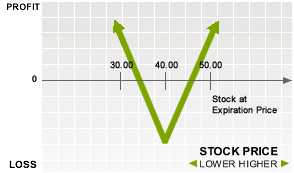 Refresh December 13, 2025 11:05 AM ET
Refresh December 13, 2025 11:05 AM ET
Apply for an options account Already a brokerage customer?
|
A Long Straddle is a strategy involving a long call position and a long put position at the same strike price. This strategy results in a net premium paid (debit) upon initial order entry based on the current value of the put and call.
Uses This strategy is normally used when the option trader is very bullish or very bearish over a short time. The option trader wants to capitalize on a sudden change in underlying price movement, but may not know what direction that price movement may be. This strategy can also be used when the option trader wants to take advantage of a sudden increase in implied volatility. Risks This strategy is considered to have limited risk and high reward. The maximum gain does not have a limit and occurs when the stock dramatically decreases or increases away from the current strike price. The potential maximum loss is limited to the net debit initially paid for the put and call option. Price movement is a key component in the value of this strategy. All other risk factors being equal, an increase or decrease in the price of the underlying security will result in an increase in the value of this strategy. Neutral activity resulting in the price of the underlying security staying near the strike price may adversely affect this strategy. Volatility can also have a significant impact on this position. All other risk factors being equal, increases in implied volatility have a very favorable effect on this strategy. Decreases in implied volatility have a negative effect. In this strategy, time decay is not the option trader's friend. A passage in time, all other things being equal, will result in a decline in strategy value. Options traders have exercise risk on this trade, but not assignment risk. Early assignment (American Style) on the long option is at the discretion of the long option holder. Exercise risk should be considered when holding long options through expiration. Allowing a long option to exercise would result in the option trader taking a short or long position in the underlying security, which could open the option trader to more risk than originally expected on the long straddle position alone. When exercise risk is a concern, the best course of action may be to close the strategy prior to potential exercise.
Important Note: Options involve risk and are not suitable for all investors. For more information, please read the Characteristics and Risks of Standardized Options. |

 Back to Top
Back to Top